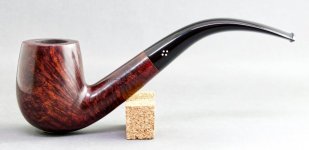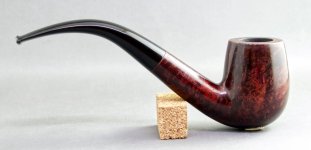In the collecting world, from cars to watches to pipes, there are ultra-rare, never used, never sold "time capsule" specimens, and there are desirable specimens, but they hardly ever overlap.
Meaning, not many people care about a zero-miles Yugo with the option sticker still in the window, but a semi-restored semi-original AC Cobra roadster in meh condition will create significant interest.
When a lightly driven, never restored, 100% original AC Cobra roadster turns up, though---when rarity and desirability overlap---it makes the news.
So, condition:
Though this Sasieni was owned and lightly smoked, it was never reamed much, or more importantly BUFFED much. Maybe not at all. (early Sasieni nomenclature is notoriously shallow and delicate) Except for some light "pocket knock" compression dings and the chamber wall being black, the pipe is essentially new.
Desirability:
The early Viscount Lascelles was Sasieni's entry in the "swan neck" sweepstakes. A period when the top British makers wanted their flagship shapes to look streamlined and have flow, regardless of the manufacturing difficulties involved. (The period didn't last long because of tho$e difficultie$, but boy howdy are today's collectors glad it happened at all.)
Net Result:

PS --- Any of you nomenclature decoder guys who can pin down the manufacturing year(s), please fire away.




Meaning, not many people care about a zero-miles Yugo with the option sticker still in the window, but a semi-restored semi-original AC Cobra roadster in meh condition will create significant interest.
When a lightly driven, never restored, 100% original AC Cobra roadster turns up, though---when rarity and desirability overlap---it makes the news.
So, condition:
Though this Sasieni was owned and lightly smoked, it was never reamed much, or more importantly BUFFED much. Maybe not at all. (early Sasieni nomenclature is notoriously shallow and delicate) Except for some light "pocket knock" compression dings and the chamber wall being black, the pipe is essentially new.
Desirability:
The early Viscount Lascelles was Sasieni's entry in the "swan neck" sweepstakes. A period when the top British makers wanted their flagship shapes to look streamlined and have flow, regardless of the manufacturing difficulties involved. (The period didn't last long because of tho$e difficultie$, but boy howdy are today's collectors glad it happened at all.)
Net Result:

PS --- Any of you nomenclature decoder guys who can pin down the manufacturing year(s), please fire away.


























